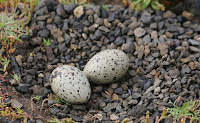BLACK OYSTERCATCHER
BLACK OYSTERCATCHER (Haematopus bachmani) – (See images below)
DESCRIPTION: The Black Oystercatcher adult head and neck are black and rest of body charcoal. Eye is yellow with a red eye ring. Sturdy, dagger-like bill is red and longer than head. Legs and feet are pink. Sexes are similar. Juvenile bill has a dark tip. Bird length is about 42 cm (17 inches).
VOICE: https://www.xeno-canto.org/species/Haematopus-bachmani
NAME: ‘Oystercatcher’ refers to this bird’s diet. Latin genus name ‘Haematopus’ means ‘blood-red foot’. Latin species name ‘bachmani’ was given to honor American naturalist John Bachman.
HABITAT: Prefers rocky coasts in intertidal zones.
DIET: Molluscs (mostly mussels and limpets), crabs and other invertebrates. Pries shells open with its strong bill. Rarely feeds on oysters in spite of its name.
BREEDING/NESTING: Pairs mate for life. Nest is a shallow depression on an island shore, lined with small pebbles. Two or three green-beige eggs are laid, incubated by both parents, who also both feed the chicks. Nests are vulnerable to disturbance. Even if they don’t swim, chicks may hide under water to avoid predators.
DISTRIBUTION: Year round residents along south coast of Alaska (where water remains ice free), west coast of British Columbia, western USA, and north half of Baja California. Some northern groups may winter in the southern range.
Distribution Map: https://en.wikipedia.org/wiki/Black_oystercatcher#/media/File:Haematopus_bachmani_map.svg
ON PEI: Does not breed on Prince Edward Island, sightings listed as ‘accidental’ so far. See note below on bird vagrancy. A first reported sighting was at Malpeque Bay in August 2011.
CONSERVATION: Population appears stable and currently not at risk, but species is vulnerable to pollution from oil and other toxic compounds. It is locally of concern though due to its small population – in the 15,000 range.
Vagrancy: In biology this means an animal going way outside its normal range. For birds, this can happen when there are storms and they get blown off course. On other times, the bird simply wanders in a different direction than usual. Here’s an article about vagrancy in birds.
SIMILAR SPECIES: Variable Oystercatcher
REFERENCES: http://identify.whatbird.com/obj/999/overview/Black_Oystercatcher.aspx
https://en.wikipedia.org/wiki/Black_oystercatcher
https://www.audubon.org/field-guide/bird/black-oystercatcher
https://www.fws.gov/oregonfwo/articles.cfm?id=149489419
https://www.nps.gov/chis/learn/nature/oystercatcher.htm (Channel Islands National Park, CA)
https://www.fws.gov/refuges/birding/blackOystercatcher.html
https://www.birdatlas.bc.ca/accounts/speciesaccount.jsp?sp=BLOY&lang=en (British Columbia Breeding Bird Atlas)
http://www.oiseaux-birds.com/card-blackish-oystercatcher.html
https://www.allaboutbirds.org/guide/Black_Oystercatcher/id
DESCRIPTION: The Black Oystercatcher adult head and neck are black and rest of body charcoal. Eye is yellow with a red eye ring. Sturdy, dagger-like bill is red and longer than head. Legs and feet are pink. Sexes are similar. Juvenile bill has a dark tip. Bird length is about 42 cm (17 inches).
VOICE: https://www.xeno-canto.org/species/Haematopus-bachmani
NAME: ‘Oystercatcher’ refers to this bird’s diet. Latin genus name ‘Haematopus’ means ‘blood-red foot’. Latin species name ‘bachmani’ was given to honor American naturalist John Bachman.
HABITAT: Prefers rocky coasts in intertidal zones.
DIET: Molluscs (mostly mussels and limpets), crabs and other invertebrates. Pries shells open with its strong bill. Rarely feeds on oysters in spite of its name.
BREEDING/NESTING: Pairs mate for life. Nest is a shallow depression on an island shore, lined with small pebbles. Two or three green-beige eggs are laid, incubated by both parents, who also both feed the chicks. Nests are vulnerable to disturbance. Even if they don’t swim, chicks may hide under water to avoid predators.
DISTRIBUTION: Year round residents along south coast of Alaska (where water remains ice free), west coast of British Columbia, western USA, and north half of Baja California. Some northern groups may winter in the southern range.
Distribution Map: https://en.wikipedia.org/wiki/Black_oystercatcher#/media/File:Haematopus_bachmani_map.svg
ON PEI: Does not breed on Prince Edward Island, sightings listed as ‘accidental’ so far. See note below on bird vagrancy. A first reported sighting was at Malpeque Bay in August 2011.
CONSERVATION: Population appears stable and currently not at risk, but species is vulnerable to pollution from oil and other toxic compounds. It is locally of concern though due to its small population – in the 15,000 range.
Vagrancy: In biology this means an animal going way outside its normal range. For birds, this can happen when there are storms and they get blown off course. On other times, the bird simply wanders in a different direction than usual. Here’s an article about vagrancy in birds.
SIMILAR SPECIES: Variable Oystercatcher
REFERENCES: http://identify.whatbird.com/obj/999/overview/Black_Oystercatcher.aspx
https://en.wikipedia.org/wiki/Black_oystercatcher
https://www.audubon.org/field-guide/bird/black-oystercatcher
https://www.fws.gov/oregonfwo/articles.cfm?id=149489419
https://www.nps.gov/chis/learn/nature/oystercatcher.htm (Channel Islands National Park, CA)
https://www.fws.gov/refuges/birding/blackOystercatcher.html
https://www.birdatlas.bc.ca/accounts/speciesaccount.jsp?sp=BLOY&lang=en (British Columbia Breeding Bird Atlas)
http://www.oiseaux-birds.com/card-blackish-oystercatcher.html
https://www.allaboutbirds.org/guide/Black_Oystercatcher/id
 |
| Black oystercatcher, CA, by Dick Daniels |
 |
| Black oystercatcher chick, AK, by Mikaela Howie, USFWS |
 |
| Black oystercatcher, Peter Pearsall, USFWS |